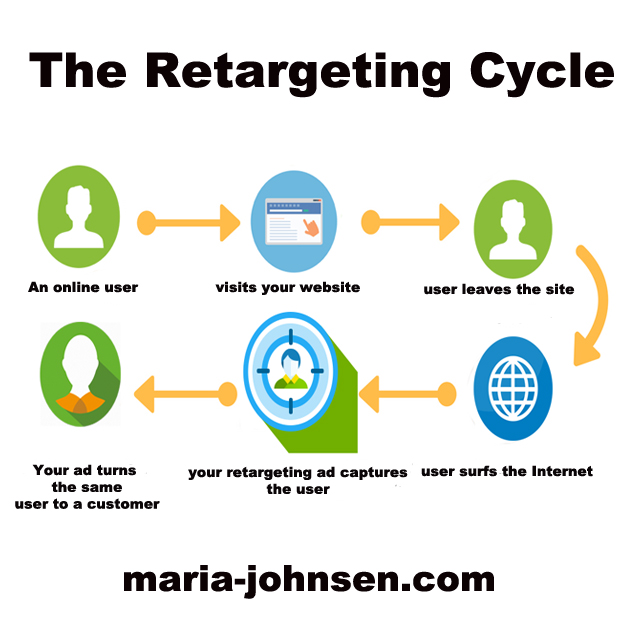The Good News About Retargeting And Remarketing
Retargeting And Remarketing requires having some effective strategies to boost sales. Effective marketing of your business starts with understanding most of the terms associated with online advertising and knowing their effects. Unfortunately, there are many terms that on the surface seemingly mean the same thing when there are substantial differences.
One of the most common misperceptions is the meaning of retargeting and remarketing. On the surface, they seem to mean the same thing. However, there is at least one substantial difference that you will need to know before employing either marketing tactic.

What is Retargeting?
This term is used most often to describe the placement or display of advertising online based on the activities of the users who visit your site. When someone visits your site, a browser cookie is placed which tracks the search habits of the person. As the person visits other sites, they will be encouraged by the cookie to return to your site by retargeting the ads that they see. This effect only exists for those who have shown a genuine interest in your site, but have not make a purchase at the current time.
While effective, retargeting is not a singular marketing strategy and it needs to be paired with other advertising efforts for it to be successful. Good content marketing, a specific ad campaign, and other methods work well with retargeting efforts, especially when directed at single products or line of products that all follow a singular theme.

What is Remarketing?
Remarketing is different in that it uses the information gathered when a site is visited and places it into an email that is sent to the lead or potential customer at a later point. However you can use remarketing in Google ads and Facebook ads as well. This is an old tactic when in the pre-internet days a letter would be sent to the home of the lead who showed interest in the products or services of the business.
Like retargeting, remarketing also works well when combined with other marketing efforts. Although, when combined with email, the effect should be more personalized in nature. This means that if you have other means to personally target users with content that is specific to their interests. Other marketing effort such as good content, ad campaigns, and the like only add to the effect.
Some marketers confuse remarketing with retargeting. But as i have stated there are some slight differences. You can use both of them in your digital marketing campaigns. Google ads made some changes in remarketing in 2018 in order to give people more control of the ads they see. Google can mute your remarketing ads for 3 months if they become spammy. You cannot use your remarketing ads forever. In remarketing a user who left your website will see your ad on other website in the same niche.
Apple’s operating system lately introduced Intelligent Tracking Prevention in which artificial intelligence is implemented. Users who have blocked tracking cookies on their Safari browsers, cannot be targeted. However if the same user visits your ad again, the cookie will be enabled after 24 hours.
In retargeting campaigns, you target specific website’s visitors with specific ads and get them to convert. In remarketing you promote the same ad. The good news about both retargeting and remarketing is that it can be used by businesses in most industries, whether they sell goods, services, or both. The flexibility combined with the direct nature of both marketing concepts means a far better chance of turning a lead into a customer. You will need to emphasize your sales conversion efforts so that when they are ready to buy, it becomes an easy experience. Some remarketing tactics are: diversifying type of ads and channels where you think your prospects can be found, categorizing your audience based on their interest, monitoring your audience and tweaking your ads.
Some Remarketing tools:
Google Ads: Static marketing, Dynamic marketing, search ads, email list marketing and display ads remarketing
Adroll: It has access to advertising partners Google, Facebook,Yahoo, Bing, Twitter
Some Retargeting tools:
retargeter.com
Facebook retargeting with custom audience
Perfect Audience: They provide solutions for Mobile, Dynamic, Web, and Facebook Retargeting
Exact Drive
These are tools i use for remarketing and retargeting for my clients. I am sure there are more tools online.
So, while there are differences between retargeting and remarketing, they are often used together to maximize the marketing efforts which expand the customer base.In remarketing you market the same ad, in retargeting you target the same user to get them buy from you. In other words, remarketing offers a direct appeal to the potential customer while retargeting provides a subtler approach in the placement of ads and other information.Working together, it’s possible to maximize the appeal of your business without going over the top or pushing too hard.
Impact of Artificial Intelligence on Paid Advertising
Multilingual PPC Ad Management

Retargeting is not waste of time and money. It will have a positive effect and increases ROI. It will keep a brand top of mind with customers in the early stages of the buying cycle.
Many ecommerce businesses use both retargeting and remarketing to land sales. Some software service providers use mostly retargeting strategy.
The display retargeting and email remarketing actually play really well together. Use display retargeting to nurture top of the funnel interest to keep your brand fresh in customer’s minds. Use email remarketing to convert the customers who’ve reached the very bottom of your funnel and are giving you the strongest signals of buying intent.
I agree. There are some great tools out there to help with retargeting.
Remarketing drives a higher conversion, we’ve got great results.
Retargeting can be annoying and create a feeling of mistrust
If we pay attention to the frequency, context and recency, we can achieve great results through retargeting and remarketing.
Retargeting and remarketing are great for ecommerce. Great article Maria, Thanks for sharing it with us.
There is no doubt that it increases conversion rate because not many people buy the product when they click at my ad.
Who cares! You have to do anything to sell your product whether it is through retargeting or remarketing.
Many use remarketing to increase their revenue. It depends on how you use it and your techniques. It works like a charm for selling ecommerce products.
I usually use this both of them for selling my clients’ webshop products.
Agree with Maria. We have to use both of them in order to maximize sales.
I use remarketing very often because my ad will show up to relevant users as they browse other websites in my ad network based on my bid and preferences. My ads also appear when users search for terms related to my products on Google or other search engines. I love it.
That’s great. Thanks for sharing, Judith
I think retargeting is a great way to sell a product. Sometimes a prospect is not ready to buy the product, so retargeting helps with decision making process.
Yeah I agree. The remarketing will keep the prospects engaged with my brand.
It increases the chance of sales, but it depends on the type of strategy you are using. It doesn’t work for everybody, though.
Thank you for an awesome article, Maria. You are truly a great teacher. I have learned a lot from all these articles. My friend had discussed some of your thoughts at her lecture. Your articles are inspiring and solve some of important problems in digital world.
It is not possible to measure the true impact of a display ad.
With remarketing, you can create highly targeted and personalized ad campaigns depending on which sections of your site a user visits, or even which action she takes.
A person can’t do more to express interest in buying a product. A product owner should trigger interest during branding process.
I agree with you, Karen. It depends on where you live, you can’t use the same strategy everywhere. People respond differently in every country and local area. So, yes you should know how to get people to become interested in your product or service.